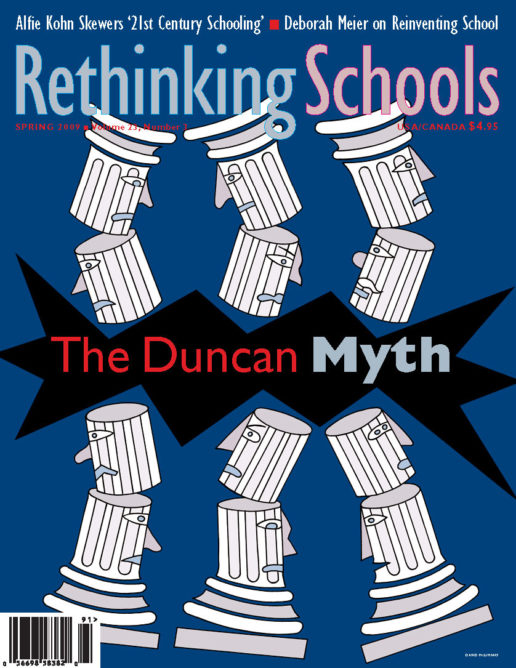Preview of Article:
Tellin’ Stories, Finding Common Ground
Illustrator: Jordin Isip
In October 1999, a small group of African American and Latino parents gathered at Washington D.C.’s Bruce-Monroe Elementary School to begin a workshop series facilitated by Teaching for Change’s parent empowerment project Tellin’ Stories. During the first workshop, the organizers placed a “story fortune” bag in the middle of the room. The bag was filled with evocative storytelling prompts, such as “My first day of school,” “A time my Mom/Dad made me proud,” and “A time I felt I had no voice.” As the parents chose prompts and shared stories, they began to build bonds of empathy. During the next few weeks, they shared stories and participated in other trust-building activities through which they talked about their challenges, their children, and positive and negative experiences with the school.
This is how Tellin’ Stories used story sharing to begin a collaborative quilting project. Each parent participating in the workshop designed and completed a square that included images and a written message embodying a crucial and sustaining life story. A parent, Rodney McDaniel, recalls the impact of this weaving together of stories. “Through the quilt, you would take a little part of your experience and make it into art, and we would sew it onto the quilt,” McDaniel said. “One African American parent … had a child who died, the victim of a violent attack. We had a Hispanic parent who had a child killed through a violent act. Even though they didn’t speak the same language, they were brought together and turned out to be the best of friends because of the common ground they had.”
In close collaboration with the Tellin’ Stories staff, these workshop participants went on to form the Parents and Friends of Bruce-Monroe. The parent group has gone on to play an important role at the school, which currently serves 370 students and is in the process of transitioning into a bilingual program. The Bruce-Monroe story illustrates the considerable potential of parent organizing to contribute to equity-driven urban school reform. The need for such reform is starkly evident within the troubled D.C. public school system. For decades, DCPS has struggled with widespread academic underachievement, an inefficient bureaucracy, and aging and inadequate buildings. Frequent turnover of top leadership—seven superintendents in 10 years—has meant a roller coaster succession of changing policies and programs. These difficulties have been exacerbated by a failure to consistently involve parents—especially low-income black and Latino parents—as essential and respected partners in the education of their own children.

